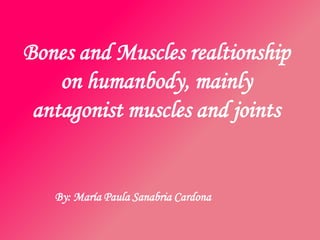
Muscles
- 1. Bones and Muscles realtionship on humanbody, mainly antagonist muscles and joints By: María Paula Sanabria Cardona
- 2. MUSCLE TYPES • The body has many paired muscles, some voluntary that are attached to the skeleton and help the body move, some involuntary that work the internal organs and cannot be controlled. • Muscles and posture also go hand in hand, where regular exercise tones muscle and improves your posture to reduce strain on other parts of the body
- 3. INVOLUNTARY MUCLES The body's involuntary muscles work our internal organs. They are outside our control. The heart is made of a unique muscle type known as cardiac and it never tires.
- 4. VOLUNTARY MUSCLES • Voluntary muscles make the body move. • Voluntary muscles are attached to the skeleton and can be controlled. Voluntary muscles have fast twitch and slow twitch fibres.
- 5. VOLUNTARY MUSCLES FAST TWITCH FIBRES SLOW TWITCH FIBRES • Contract quickly, but do not • Contract slowly, but use use oxygen well and tire oxygen well and keep going for quickly. a long time. • Top sprinters have more 'fast • Endurance athletes tend to twitch' fibres. have more 'slow twitch' fibres.
- 6. Key voluntary muscles used in sport
- 7. Origin And Insertion Of Muscles The point of attachment for each muscle are termed the origin and the insertion • The origin is the end of a muscle which is attached to a fixed bone. • The insertion is the end of the muscle that is attached to the bone which moves.
- 8. Muscles and Movement Muscles contract when they work If create movement If no resulting movement Anisotonic Contraction Isometric Contraction Can be Can be Concentric Eccentric Which is where the Where The Fibres muscle shortens as Contract As The the fibres contract Muscle Lengthens
- 9. Muscle pairs • Antagonistic pairs of muscles create movement when one (the prime mover) contracts and the other (the antagonist) relaxes. Examples of antagonistic pairs working are: • the quadriceps and hamstrings in the leg • the biceps and triceps in the arm.
- 11. PLATYSMA • ACTION Depresses and wrinkles skin of lower face and mouth. Aids forced depression of mandible
- 13. BICEPS FEMORIS • ACTION Flexes and laterally rotates knee. Long head extends hip
- 14. SEMITENDINOSUS • ACTION Flexes and medially rotates knee. Extends hip.
- 15. SEMIMEMBRANOSUS • ACTION Flexes and medially rotates knee. Extends hip
- 17. PERONEUS LONGUS • ACTION Plantar flexes and everts foot. Supports lateral longitudinal and transverse arches
- 18. GASTROCNEMIUS • ACTION Plantar flexes foot. Flexes knee
- 19. SOLEUS • ACTION Plantar flexes foot (aids venous return)
- 20. PLANTARIS • ACTION Plantar flexes foot and flexes knee
- 21. TIBIALIS POSTERIOR • ACTION Plantar flexes and inverts foot. Supports medial longitudinal arch of foot
- 22. Muscle tone and posture • Muscle tone can be seen when muscles are in a state of slight tension and they are ready for action. Regular training tones muscles and helps to create good posture. In addition, muscles will hypertrophy (increase in size) and develop better endurance. • Muscle tone developed by regular exercise makes daily tasks such as shopping and gardening easier. It also helps to prevent injury as good posture reduces the strain on muscles, tendons and ligaments.
- 23. Muscle tone and posture • Good posture helps with sporting performance as special positions are often crucial to success, eg the position throughout the golf swing. • People with good posture also feel better about themselves. An upright body position is often a sign of self confidence. People who are less confident will sometimes show this in their body language, for example by adopting a slouched posture.
- 24. REFERENCES • http://www.bbc.co.uk/schools/gcsebitesize/p e/appliedanatomy/3_anatomy_muscles_rev5. shtml • http://webanatomy.net/anatomy/muscle_acti ons.htm